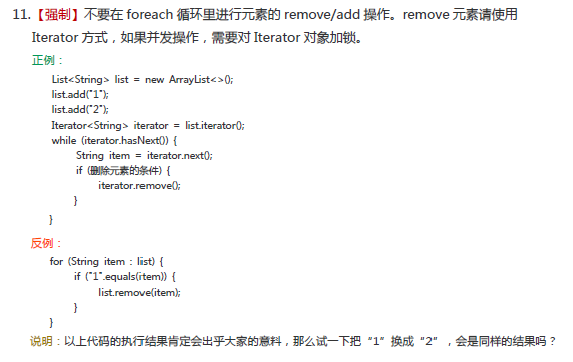阿里Java开发规约:禁止在foreach里执行元素的删除操作
6.8 Java foreach 循环陷阱
这篇文章同样采用小二去面试的形式,给大家换个胃口。
那天,小二去阿里面试,面试官老王一上来就甩给了他一道面试题:为什么阿里的 Java 开发手册里会强制不要在 foreach 里进行元素的删除操作?

小二听完这句话就乐了。为什么呢?因为一天前他刚在《二哥的Java进阶之路》上看到过这道题的答案。
以下是整篇文章的内容。
关于fail-fast
为了镇楼,先搬一段英文来解释一下 fail-fast。
In systems design, a fail-fast system is one which immediately reports at its interface any condition that is likely to indicate a failure. Fail-fast systems are usually designed to stop normal operation rather than attempt to continue a possibly flawed process. Such designs often check the system's state at several points in an operation, so any failures can be detected early. The responsibility of a fail-fast module is detecting errors, then letting the next-highest level of the system handle them.
这段话的大致意思就是,fail-fast 是一种通用的系统设计思想,一旦检测到可能会发生错误,就立马抛出异常,程序将不再往下执行。
public void test(Wanger wanger) {
if (wanger == null) {
throw new RuntimeException("wanger 不能为空");
}
System.out.println(wanger.toString());
}
一旦检测到 wanger 为 null,就立马抛出异常,让调用者来决定这种情况下该怎么处理,下一步 wanger.toString() 就不会执行了——避免更严重的错误出现。
很多时候,我们会把 fail-fast 归类为 Java 集合框架的一种错误检测机制,但其实 fail-fast 并不是 Java 集合框架特有的机制。
for-each 删除元素报错
之所以我们把 fail-fast 放在集合框架篇里介绍,是因为问题比较容易再现。
List<String> list = new ArrayList<>();
list.add("沉默王二");
list.add("沉默王三");
list.add("一个文章真特么有趣的程序员");
for (String str : list) {
if ("沉默王二".equals(str)) {
list.remove(str);
}
}
System.out.println(list);
这段代码看起来没有任何问题,但运行起来就报错了。

根据错误的堆栈信息,我们可以定位到 ArrayList 的第 901 行代码。
final void checkForComodification() {
if (modCount != expectedModCount)
throw new ConcurrentModificationException();
}
也就是说,remove 的时候触发执行了 checkForComodification 方法,该方法对 modCount 和 expectedModCount 进行了比较,发现两者不等,就抛出了 ConcurrentModificationException 异常。
为什么会执行 checkForComodification 方法呢?
是因为 for-each 本质上是个语法糖,底层是通过迭代器 Iterator 配合 while 循环实现的,来看一下反编译后的字节码。
List<String> list = new ArrayList();
list.add("沉默王二");
list.add("沉默王三");
list.add("一个文章真特么有趣的程序员");
Iterator var2 = list.iterator();
while(var2.hasNext()) {
String str = (String)var2.next();
if ("沉默王二".equals(str)) {
list.remove(str);
}
}
System.out.println(list);
来看一下 ArrayList 的 iterator 方法吧:
public Iterator<E> iterator() {
return new Itr();
}
内部类 Itr 实现了 Iterator 接口,这是 Itr 的源码。
private class Itr implements Iterator<E> {
int cursor; // 下一个元素的索引
int lastRet = -1; // 上一个返回元素的索引;如果没有则为 -1
int expectedModCount = modCount; // ArrayList 的修改次数
Itr() { } // 构造函数
public boolean hasNext() { // 判断是否还有下一个元素
return cursor != size;
}
@SuppressWarnings("unchecked")
public E next() { // 返回下一个元素
checkForComodification(); // 检查 ArrayList 是否被修改过
int i = cursor; // 当前索引
Object[] elementData = ArrayList.this.elementData; // ArrayList 中的元素数组
if (i >= elementData.length) // 超出数组范围
throw new ConcurrentModificationException(); // 抛出异常
cursor = i + 1; // 更新下一个元素的索引
return (E) elementData[lastRet = i]; // 返回下一个元素
}
}
也就是说 new Itr() 的时候 expectedModCount 被赋值为 modCount,而 modCount 是 ArrayList 中的一个计数器,用于记录 ArrayList 对象被修改的次数。ArrayList 的修改操作包括添加、删除、设置元素值等。每次对 ArrayList 进行修改操作时,modCount 的值会自增 1。
在迭代 ArrayList 时,如果迭代过程中发现 modCount 的值与迭代器的 expectedModCount 不一致,则说明 ArrayList 已被修改过,此时会抛出 ConcurrentModificationException 异常。这种机制可以保证迭代器在遍历 ArrayList 时,不会遗漏或重复元素,同时也可以在多线程环境下检测到并发修改问题。
protected transient int modCount = 0;
分析代码执行的逻辑
我们来继续定位之前报错的错误堆栈。这是之前的代码。
List<String> list = new ArrayList<>();
list.add("沉默王二");
list.add("沉默王三");
list.add("一个文章真特么有趣的程序员");
for (String str : list) {
if ("沉默王二".equals(str)) {
list.remove(str);
}
}
System.out.println(list);
由于 list 此前执行了 3 次 add 方法。
- add 方法调用 ensureCapacityInternal 方法
- ensureCapacityInternal 方法调用 ensureExplicitCapacity 方法
- ensureExplicitCapacity 方法中会执行
modCount++
private void ensureExplicitCapacity(int minCapacity) {
modCount++;
}
所以 modCount 的值在经过三次 add 后为 3,于是 new Itr() 后 expectedModCount 的值也为 3(回到前面去看一下 Itr 的源码)。
接着来执行 for-each 的循环遍历。
执行第一次循环时,发现“沉默王二”等于 str,于是执行 list.remove(str)。
- remove 方法调用 fastRemove 方法
- fastRemove 方法中会执行
modCount++
private void fastRemove(int index) {
modCount++;
}
modCount 的值变成了 4。
第二次遍历时,会执行 Itr 的 next 方法(String str = (String) var3.next();),next 方法就会调用 checkForComodification 方法。
final void checkForComodification() {
if (modCount != expectedModCount)
throw new ConcurrentModificationException();
}
此时 expectedModCount 为 3,modCount 为 4,就只好抛出 ConcurrentModificationException 异常了。
那其实在阿里巴巴的 Java 开发手册里也提到了,不要在 for-each 循环里进行元素的 remove/add 操作。remove 元素请使用 Iterator 方式。

那原因其实就是我们上面分析的这些,出于 fail-fast 保护机制。
那该如何正确地删除元素呢?
1)remove 后 break
List<String> list = new ArrayList<>();
list.add("沉默王二");
list.add("沉默王三");
list.add("一个文章真特么有趣的程序员");
for (String str : list) {
if ("沉默王二".equals(str)) {
list.remove(str);
break;
}
}
break 后循环就不再遍历了,意味着 Iterator 的 next 方法不再执行了,也就意味着 checkForComodification 方法不再执行了,所以异常也就不会抛出了。
但是呢,当 List 中有重复元素要删除的时候,break 就不合适了。
2)for 循环
List<String> list = new ArrayList<>();
list.add("沉默王二");
list.add("沉默王三");
list.add("一个文章真特么有趣的程序员");
for (int i = 0; i < list.size(); i++) {
String str = list.get(i);
if ("沉默王二".equals(str)) {
list.remove(str);
}
}
for 循环虽然可以避开 fail-fast 保护机制,也就说 remove 元素后不再抛出异常;但是呢,这段程序在原则上是有问题的。为什么呢?
第一次循环的时候,i 为 0,list.size() 为 3,当执行完 remove 方法后,i 为 1,list.size() 却变成了 2,因为 list 的大小在 remove 后发生了变化,也就意味着“沉默王三”这个元素被跳过了。能明白吗?
remove 之前 list.get(1) 为“沉默王三”;但 remove 之后 list.get(1) 变成了“一个文章真特么有趣的程序员”,而 list.get(0) 变成了“沉默王三”。
3)使用 Iterator
List<String> list = new ArrayList<>();
list.add("沉默王二");
list.add("沉默王三");
list.add("一个文章真特么有趣的程序员");
Iterator<String> itr = list.iterator();
while (itr.hasNext()) {
String str = itr.next();
if ("沉默王二".equals(str)) {
itr.remove();
}
}
为什么使用 Iterator 的 remove 方法就可以避开 fail-fast 保护机制呢?看一下 remove 的源码就明白了。
public void remove() {
if (lastRet < 0) // 如果没有上一个返回元素的索引,则抛出异常
throw new IllegalStateException();
checkForComodification(); // 检查 ArrayList 是否被修改过
try {
ArrayList.this.remove(lastRet); // 删除上一个返回元素
cursor = lastRet; // 更新下一个元素的索引
lastRet = -1; // 清空上一个返回元素的索引
expectedModCount = modCount; // 更新 ArrayList 的修改次数
} catch (IndexOutOfBoundsException ex) {
throw new ConcurrentModificationException(); // 抛出异常
}
}
删除完会执行 expectedModCount = modCount,保证了 expectedModCount 与 modCount 的同步。
小结
为什么不能在foreach里执行删除操作?
因为 foreach 循环是基于迭代器实现的,而迭代器在遍历集合时会维护一个 expectedModCount 属性来记录集合被修改的次数。如果在 foreach 循环中执行删除操作会导致 expectedModCount 属性值与实际的 modCount 属性值不一致,从而导致迭代器的 hasNext() 和 next() 方法抛出 ConcurrentModificationException 异常。
为了避免这种情况,应该使用迭代器的 remove() 方法来删除元素,该方法会在删除元素后更新迭代器状态,确保循环的正确性。如果需要在循环中删除元素,应该使用迭代器的 remove() 方法,而不是集合自身的 remove() 方法。
就像这样。
List<String> list = new ArrayList<>();
list.add("沉默王二");
list.add("沉默王三");
list.add("一个文章真特么有趣的程序员");
Iterator<String> itr = list.iterator();
while (itr.hasNext()) {
String str = itr.next();
if ("沉默王二".equals(str)) {
itr.remove();
}
}
除此之外,我们还可以采用 Stream 流的filter() 方法来过滤集合中的元素,然后再通过 collect() 方法将过滤后的元素收集到一个新的集合中。
List<String> list = new ArrayList<>(Arrays.asList("沉默", "王二", "陈清扬"));
list = list.stream().filter(s -> !s.equals("陈清扬")).collect(Collectors.toList());
好了,关于这个问题,就聊到这里吧,希望能帮助到你。
GitHub 上标星 7600+ 的开源知识库《二哥的 Java 进阶之路》第一版 PDF 终于来了!包括Java基础语法、数组&字符串、OOP、集合框架、Java IO、异常处理、Java 新特性、网络编程、NIO、并发编程、JVM等等,共计 32 万余字,可以说是通俗易懂、风趣幽默……详情戳:太赞了,GitHub 上标星 7600+ 的 Java 教程
微信搜 沉默王二 或扫描下方二维码关注二哥的原创公众号沉默王二,回复 222 即可免费领取。

